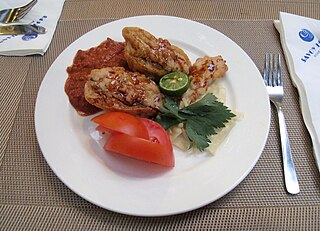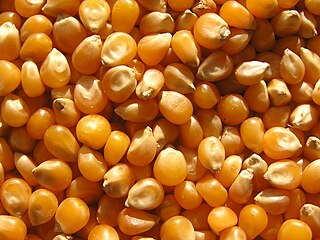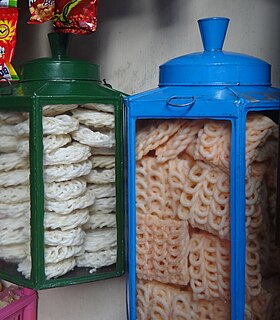
Cashew chicken is a Chinese-American dish that combines chicken, with cashews and either a light brown garlic sauce or a thick sauce made from chicken stock, soy sauce and oyster sauce.

Tahu goreng or Tauhu goreng is an Indonesian dish of fried tofu commonly found in Indonesia, Malaysia and Singapore.

Shrimp paste or prawn sauce is a fermented condiment commonly used in Southeast Asian and Southern Chinese cuisines. It is primarily made from finely crushed shrimp or krill mixed with salt, and then fermented for several weeks. They are either sold in their wet form or are sun-dried and either cut into rectangular blocks or sold in bulk. It is an essential ingredient in many curries, sauces and sambal. Shrimp paste can be found in many meals in Indonesia, Cambodia, Laos, Malaysia, Myanmar, the Philippines, Singapore, Thailand, and Vietnam. It is often an ingredient in dip for fish or vegetables.

Lontong is an Indonesian dish made of compressed rice cake in the form of a cylinder wrapped inside a banana leaf, commonly found in Indonesia, Malaysia and Singapore. Rice is rolled inside a banana leaf and boiled, then cut into small cakes as a staple food replacement of steamed rice. The texture is similar to those of ketupat, with the difference being that the ketupat container is made from woven janur fronds, while lontong uses banana leaf instead.

Javanese cuisine is the cuisine of Javanese people, a major ethnic group in Indonesia, more precisely the province of Central Java, Yogyakarta and East Java. Though the cuisine of Sumatra is known for its spiciness with notable Indian and Arabic influences, Javanese cuisine is more indigenously developed and noted for its simplicity. Some of Javanese dishes demonstrate foreign influences, most notably Chinese.

Squid is eaten in many cuisines; in English, the culinary name calamari is often used for squid dishes. There are many ways to prepare and cook squid. Fried squid is common in the Mediterranean. In Lebanon and Syria, however, it is served with tartar sauce. In New Zealand, Australia, the United States, and South Africa, it is sold in fish and chip shops. In Britain, it can be found in Mediterranean 'calamari' or Asian 'salt and pepper fried squid' forms in various establishments, often served as a bar snack, street food, or starter.

Batagor is a Sundanese dish from Indonesia, and popular in Southeast Asia, consisting of fried fish dumplings, usually served with peanut sauce. It is traditionally made from minced tenggiri (wahoo) fish meat, although other types of seafood such as tuna, mackerel, and prawn may also be used. The fish paste is subsequently stuffed into wonton skins or filled into tofu, and then deep fried in palm oil.

Beninese cuisine is known in Africa for its exotic ingredients and flavorful dishes. Beninese cuisine involves many fresh meals served with a variety of sauces. Meat is usually quite expensive, and meals are generally light on meat and generous on vegetable fat.

Krupuk kulit is a traditional Indonesian cattle skin krupuk (cracker). Traditionally it is made from the soft inner skin of cattle, diced, and sun-dried until it hardens and loses most of its water content. The diced and dried skin are later fried in ample hot cooking oil until they expand in similar fashion with bubble and yield a crispy texture. This fried cattle skin is then sealed in vacuum plastic bags to ensure and prolong its crispiness.

Krupuk or kerupuk (Indonesian) or kroepoek (Dutch) is an Indonesian deep fried cracker made from starch and other ingredients that serve as flavouring. They are a popular snack in parts of Southeast Asia, but most closely associated with Indonesia. Kroepoek also can be found in the Netherlands, through their historic colonial ties with Indonesia.

Rojak or Rujak is an Indonesian — Javanese traditional fruit and vegetable salad dish, commonly found in Indonesia, Malaysia and Singapore. Other than referring to this fruit salad dish, the term rojak also means "mixture" or "eclectic mix" in colloquial Malay.

The prawn cracker is a form of deep fried snack made from starch and prawn. Prawn crackers are a common snack food in Southeast Asian cuisine, but they are most closely associated with Indonesia and Malaysia. They have also been adapted into East Asian cuisines.

Tahu campur, literally meaning "mixed tofu" in Javanese language and broader Indonesian language, is an East Javanese tofu dish. The dish consists of sliced tahu goreng, lontong, lentho or sometimes replaced by perkedel, fresh bean sprouts, fresh lettuce, yellow noodles, and krupuk crackers, served in savoury beef stew, garnished with fried onions, and sambal chili sauce. The beef stew soup is seasoned with spices and petis, a type of shrimp paste commonly used in East Javanese cuisine.

Madurese cuisine is a cuisine tradition of Madurese people from Madura Island in Indonesia. This cuisine also known in East Java as well as on the south coast of Kalimantan. Madura cuisine has salty, savoury and spicy tastes with Javanese-influenced.

Lontong balap is an Indonesian traditional rice dish, well known in Javanese cuisine, made of lontong, tauge, fried tofu, lentho, fried shallots, sambal petis and sweet soy sauce. East Javanese lontong and tofu recipes are known of their distinctive flavour, acquired from generous amount of petis. The origin of the dish is from Surabaya in East Java, Indonesia.

Indo cuisine is a fusion cooking and cuisine tradition, mainly existing in Indonesia and the Netherlands, as well as Belgium, South Africa and Suriname. This cuisine characterized of fusion cuisine that consists of original Indonesian cuisine with Eurasian-influences—mainly Dutch, also Portuguese, Spanish and British—and vice versa. Nowaday, not only Indo people who consume Indo cuisine, but also Indonesians and Dutch people.















